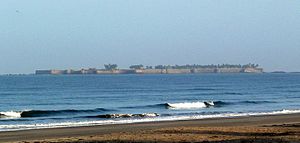Sindhudurg Fort
This article needs additional citations for verification. (October 2007) |
| Sindhudurg Fort | |
|---|---|
| Part of Maharashtra | |
| Sindhudurg district, Maharashtra | |
 Sindhudurg fortress from the mainland. | |
| Coordinates | 16°02′38″N 73°27′41″E / 16.043769°N 73.461416°ECoordinates: 16°02′38″N 73°27′41″E / 16.043769°N 73.461416°E |
| Type | Island |
| Site information | |
| Owner | Government of India |
| Controlled by | |
| Open to the public | Yes |
| Site history | |
| Built | 1664 |
| Built by | Hiroji Indulkar (Chief Architect) |
Sindhudurg Fort (Marathi pronunciation: [sin̪d̪ʱud̪uɾɡ]) is a historical fort that occupies an island in the Arabian Sea, just off the coast of Maharashtra in Western India. The fort was built by Shivaji Maharaj.The fortress lies on the shore of Malvan town of Sindhudurg District in the Konkan region of Maharashtra, 450 kilometres (280 mi) south of Mumbai.[1] It is a protected monument.[2]
History[edit]
Sindhudurg island-fort was built by Shivaji, the 17th-century ruler of Maratha Empire.[3] Its main objective was to counter the rising influence of foreign (English, Dutch, French and Portuguese) merchants and to curb the rise of Siddhis of Janjira.[4] Construction was supervised by Hiroji Indulkar in 1664. The fort was built on a small island known as the Khurte island.
Structural details[edit]
Shivaji had brought 200 Vaddera people to build this fort. Over 4,000 pounds of lead were used in the casting and foundation stones were firmly laid down. Construction started on 25 November 1664. Built over a period of three years (1664-1667), the sea fort is spread over 48 acres, with a two-mile (3 km) long rampart, and walls that are 30 feet (9.1 m) high and 12 feet (3.7 m) thick. The massive walls were designed to serve as a deterrent to approaching enemies and to the waves and tides of the Arabian Sea. The main entrance is concealed in such a way that no one can pinpoint it from outside.[citation needed]
At a time when traveling by sea was banned by scriptures, this construction on an island represents the revolutionary mindset of its engineer. A remain of an iron mould can be seen.
The number of permanent residents living in the fort has been in decline since its abandonment. Most residents have moved out due to inadequate employment opportunities but some families remain. The fort is closed for tourists during rainy season due to high tides.
Gallery[edit]
- Sindhudurg fort wall detail.JPG
Detail of Sindhudurg fort wall
- Singhudurg west wall.JPG
West side of fort showing a small beach and a door in the wall for beach access
See also[edit]
- Maratha Navy
- List of forts in Maharashtra
- List of forts in Mumbai
- List of forts in India
- List of forts
References[edit]
- ↑ "Sindhudurg Fort Location". Archived from the original on 5 August 2012. Retrieved 18 May 2012.
- ↑ "List of the protected monuments of Mumbai Circle district-wise" (PDF). Archived from the original on 6 June 2013.
{{cite web}}: CS1 maint: unfit URL (link) - ↑ Sen, Sailendra (2013). A Textbook of Medieval Indian History. Primus Books. p. 207. ISBN 978-9-38060-734-4.
- ↑ "Tour De Kokan : Explore Various Places & Information". Best Places to visit - Travel Information - Tour De Konkan.


